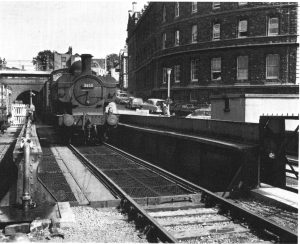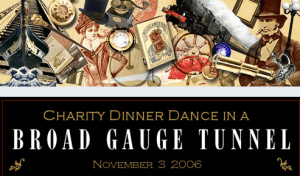The Redcliffe tunnel portal and the railway cutting to the right of the Ostrich Inn are important legacies of Bristol’s industrial past. The double track of mixed broad and standard gauge railway line from docks to Temple Meads was carried by a bascule bridge close to the Ostrich, a bridge that was actually wider than it was long and operated by a stationary steam engine. When the line closed in 1964, this engine was removed to the Industrial Museum (now M Shed). The steam engine had a secondary function, which was to assist manoeuvring large boats using the Basin both through the lock past the open bascule bridge and alongside the working quays. This was done by ropes threaded round the wheels that are still located on the quay edge by Lower Guinea street.
The railway cutting and tunnel were the work of Charles Richardson, an engineer who shaped the railways of the South West for Isambard Kingdom Brunel. Richardson was the instigator and chief engineer for the Severn Tunnel, which was an enormous feat of engineering, and the world’s longest underwater tunnel for over 100 years. Incidentally, Richardson also invented the modern-day cricket bat in the 1880s, and Brunel expressed his displeasure at Richardson sometimes becoming distracted by his interest in cricket.

Whilst awaiting parliamentary approval for the Severn Tunnel, Richardson constructed the Bristol Harbourside Railway for the Great Western Railway Company. This short but highly complex and expensive line comprised a viaduct from Temple Meads, a 260 metre long tunnel under the vicarage and cemetery of St Mary Redcliffe and the cutting and bascule bridge next to Bathurst Basin.
Railway cutting timeline
- In 1866 an act of parliament was passed to construct a new wharf at the harbourside, linked by rail to Temple Meads. The wharf was opposite where Mud Dock is today (just before Prince Street Bridge).
- In August 1868 construction started. The vicarage for St Mary Redcliffe was demolished as part of the scheme (where the Mercure Hotel is today), and bodies from the cemetery were relocated to Arno’s Vale cemetery. Housing on one side of Guinea Street (opposite the General) was also removed to construct the cutting.
- In 1869 (before the rail link was opened), the railway companies applied to Parliament again to increase the size of the wharf to the other side of Prince Street Bridge, and this is where we see the historic harbourside railway today – outside M Shed.
- In March 1872 the harbourside railway was officially opened. The Redcliffe tunnel and the bascule bridge was at the heart of this short but very important railway link. It was a costly line to build, as it was over developed urban land.
- For the next 92 years the railway was a key link for the country. Goods from the New World, Irish meat, Guinness, Scandinavian timber, steel, grain, etc. were all offloaded onto the harbourside railway, through Redcliffe tunnel and towards London via the GWR.
- For 34 years the tunnel was the only link for the harbourside railway until Ashton Avenue Swing Bridge was opened in 1906, linking the harbourside railway to the Portishead line. The harbourside railway had expanded all the way down to Cumberland Basin by this point.
- The tunnel served as an air raid shelter in WW2 for the people of Redcliffe.
- In January 1964 the line from Temple Meads to Prince Street Bridge was closed, following the closure of the Redcliffe goods yard in 1962.
And in 2006…
 200 years after the anniversary of Brunel’s birth, the Institute of Civil Engineers in the South West decided to celebrate the occasion by recreating a famous tunnel event of 1830. In that year Brunel’s father faced dwindling funds for his Rotherhyde Tunnel project after a flooding incident. Brunel had the inspirational idea of holding a dinner party in the partially completed tunnel to prove that the tunnel was safe. On 3rd November 2006, the 1830 event was re-enacted in Redcliffe tunnel, which had been prepared with lighting, dance floor and banqueting tables to seat up to 300 people.
200 years after the anniversary of Brunel’s birth, the Institute of Civil Engineers in the South West decided to celebrate the occasion by recreating a famous tunnel event of 1830. In that year Brunel’s father faced dwindling funds for his Rotherhyde Tunnel project after a flooding incident. Brunel had the inspirational idea of holding a dinner party in the partially completed tunnel to prove that the tunnel was safe. On 3rd November 2006, the 1830 event was re-enacted in Redcliffe tunnel, which had been prepared with lighting, dance floor and banqueting tables to seat up to 300 people.
